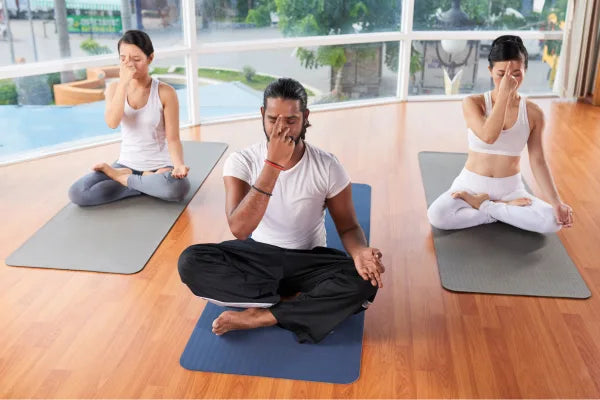
Effective Breathing Techniques to Boost Lung Health and Reduce Stress
Share
Breathing Techniques That Anyone Can Try
Listen to this Article
Table of Contents
Overview
Breathing techniques are powerful tools that can help manage stress, improve lung function, and increase relaxation. Whether you're looking to reduce anxiety, enhance mental clarity, or support your respiratory health, breathing exercises are beneficial for everyone. From deep breathing to alternate nostril breathing, there are techniques that can easily be integrated into your daily routine. In this article, we'll explore various breathing techniques and how they can positively impact your well-being.

Deep Breathing
Deep breathing is one of the most basic and effective breathing techniques. It involves breathing deeply into your diaphragm, rather than shallowly into your chest. This technique can help increase the amount of oxygen reaching your lungs and calm your nervous system.
- Inhale deeply through your nose for a count of 4, allowing your stomach to expand.
- Hold your breath for a count of 4.
- Exhale slowly through your mouth for a count of 6 to 8.
Deep breathing helps lower blood pressure and can relieve tension in the body.

Breath Focus
Breath focus involves consciously bringing your attention to your breathing, helping to calm the mind and reduce stress. This technique is ideal for those looking to improve mindfulness and concentration.
- Find a quiet place to sit comfortably.
- Focus your attention solely on your breath, noticing the sensation of air entering and leaving your body.
- If your mind wanders, gently guide your focus back to your breath.
Breath focus can be a great introduction to more complex mindfulness and meditation practices.
Equal Time for Breathing In and Out
Equal time breathing is a simple yet effective technique where you inhale and exhale for the same amount of time. This helps regulate your breath and brings balance to the nervous system.
- Inhale for a count of 4.
- Exhale for a count of 4.
- Gradually increase the duration as you become more comfortable with the practice.
This technique is especially helpful for calming anxiety and managing stress.

Progressive Muscle Relaxation
Progressive muscle relaxation (PMR) is a technique that combines breathing exercises with muscle relaxation. This method helps release physical tension and promotes deep relaxation.
- Inhale deeply and tense a muscle group (e.g., your fists or legs) for 5-10 seconds.
- Exhale and release the tension in that muscle group as you breathe out.
- Move through different muscle groups, including your arms, legs, shoulders, and face.
PMR can reduce physical tension and promote relaxation, making it an effective tool for stress management.
Modified Lion's Breath
Lion's Breath is a powerful breathing technique that involves exhaling with force while making a lion-like sound. It's often used to release pent-up stress and emotions.
- Sit comfortably with your spine straight.
- Inhale deeply through your nose.
- Exhale forcefully through your mouth, making a “ha” sound while sticking out your tongue.
This technique can help release tension in the chest and throat and improve energy levels.
For more on Lion's Breath, check out the detailed guide on Healthline.

Pursed Lip Breathing
Pursed lip breathing is an effective technique for slowing your breathing and improving airflow, especially for those with respiratory conditions like asthma or COPD.
- Inhale slowly through your nose for 2 counts.
- Exhale slowly through pursed lips (like you're blowing through a straw) for 4 counts.
Pursed lip breathing can improve lung efficiency, reduce shortness of breath, and help clear out stale air from the lungs.
Diaphragmatic Breathing
Also known as belly breathing, diaphragmatic breathing focuses on using the diaphragm to breathe deeply, allowing more air to reach the lungs and improving lung efficiency.
- Place one hand on your chest and the other on your abdomen.
- Inhale deeply through your nose, ensuring that only your abdomen rises, not your chest.
- Exhale slowly through your mouth, allowing your abdomen to fall.
This technique improves lung capacity and can help reduce stress and anxiety.

Alternate Nostril Breathing
Alternate nostril breathing is a yogic practice that involves breathing through one nostril at a time. This technique is known to balance the body’s energy and calm the mind.
- Sit in a comfortable position and use your right thumb to close your right nostril.
- Inhale deeply through the left nostril.
- Close the left nostril using your right ring finger and open the right nostril.
- Exhale slowly through the right nostril.
- Repeat, alternating nostrils for several minutes.
Alternate nostril breathing promotes balance and relaxation, making it an excellent technique for stress reduction.
Summary
- Breathing techniques can help reduce stress, improve lung function, and enhance relaxation.
- Deep breathing, diaphragmatic breathing, and pursed lip breathing are great for improving lung capacity.
- Alternative nostril breathing and Lion's Breath are effective for energy and stress release.
- Progressive muscle relaxation integrates breathing with muscle relaxation for complete body relief.
This article is for general health awareness. Please consult your doctor and medical professionals for personlized care, diagnosis and treatment.
